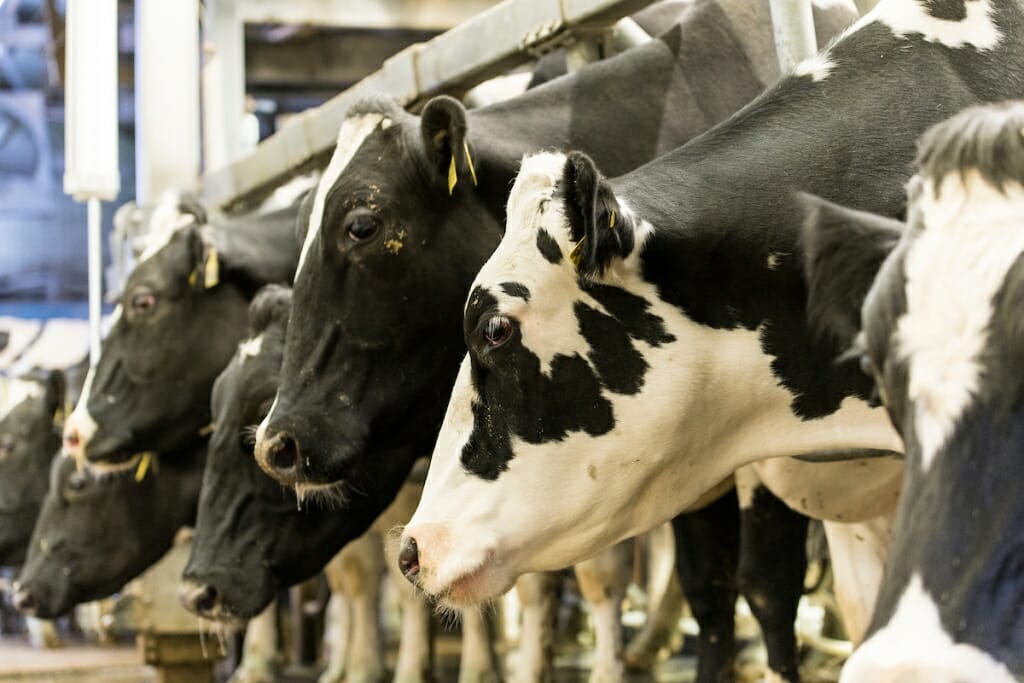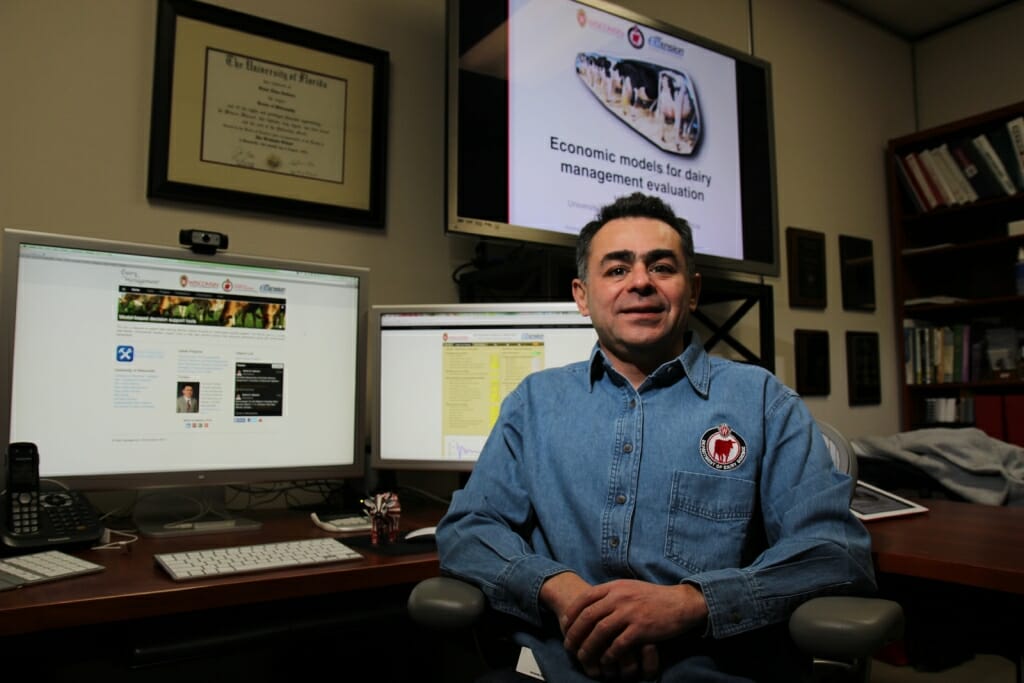‘Dairy Brain’ project asks farmers to help create smarter dairies

A herd of Holsteins during a milking session at the Sunburst Dairy Farm in Belleville, Wisconsin. UW researchers are asking dairy farmers, producers and equipment manufacturers to integrate dairy data to help farmers make useful, real-time decisions. Photo: Bryce Richter
Milk volume and composition; feed costs; market prices and weather; and cow health and genetics are just a few of the data streams swirling around dairies.
“Dairy farmers are inundated with data that they cannot use to their fullest extent,” says Victor Cabrera, a professor of dairy science and Extension specialist at the University of Wisconsin–Madison and director of Dairy Brain, an ambitious project to integrate dairy data to help farmers make useful, real-time decisions.
The project, now in its third year, aims to develop software that provides farmers with continuous readouts on the state of their operations and the health of their herds. The software could ultimately provide information on daily income after feed costs, predict the development of diseases likes mastitis, and help farmers assess the value of their animals to guide herd management.
As part of their work, the researchers are asking dairy industry members of all kinds — farmers, producers and equipment manufacturers — to join their advisory group known as a Coordinated Innovation Network. People can volunteer to participate on the project’s website.
Originally supported by a UW2020 grant in 2017, the Dairy Brain project has since secured a $1 million grant from the U.S. Department of Agriculture to improve dairy farm efficiency. The project includes more than a dozen researchers across campus and has recruited five Wisconsin farms to help them collect data and test solutions.

Victor Cabrera is director of Dairy Brain, which aims to develop software that provides farmers with continuous readouts on the state of their operations and the health of their herds. UW–Madison College of Agricultural and Life Sciences
Dairy farmers have steadily accumulated data-generating machines in recent decades. But different pieces of equipment often don’t talk to one another or readily swap data, which presents the biggest obstacle to farmers trying to squeeze useful information from their data.
“That’s the first issue,” says Cabrera. “Then we have to look at who owns the data. How do we protect the confidentiality and security of the data? How can we incentivize to share data? We need to take care of these things before we do anything else.”
Solving these problems requires working with the companies that manufacture data-generating equipment as well as processors and farmers. The Coordinated Innovation Network already boasts scores of these stakeholders from across the U.S. as well as Canada, Europe and Latin America. And the scientists are eager for more members.
“We wanted to have this group together to start an open discussion about the data challenges in the industry. Our first objective was to produce design documents to outline these challenges,” says Liliana Fadul, a postdoctoral researcher with the project. “We’ve also created a forum so we can receive feedback on these issues.”
The scientists published some of those initial design documents in Hoard’s Dairyman, which helped them reach their target audience. Cabrera’s team has also been working with UW–Madison Division of Extension colleagues to connect with farmers, teach about the value of data integration, and recruit new advisors to the project. The network has helped the researchers prioritize the outputs their software should calculate.
In addition to daily income and disease prediction, dairy and computer scientists are collaborating to determine daily feed efficiency, ideal diets and the value of genetic differences. Some readouts are easy — as long as the data are available. Others, such as disease prediction, require new machine-learning algorithms, a project Fadul is working on. Access to UW–Madison’s Center for High Throughput Computing gives Fadul and other researchers the power they need to develop these algorithms.
Given the challenges in acquiring and synthesizing data and developing code, the final software might take years to see the light of day. But the researchers hope that they can create a user-friendly app for smartphones, tablets or browsers that allows dairy farmers to hook up their equipment and easily access information about their operations.
That way, the Dairy Brain will help farmers tap into the data they already generate and run their farms more efficiently — and smarter.
This work was supported by the U.S. Department of Agriculture, Food and Agriculture Cyberinformatics Tools (FACT) Initiative: Developing a Virtual Dairy Farm Brain: The Next Big Leap in Dairy Farm Management Using Coordinated Data Ecosystems (Grant 2019-68017-29935).
Subscribe to Wisconsin Ideas
Want more stories of the Wisconsin Idea in action? Sign-up for our monthly e-newsletter highlighting how Badgers are taking their education and research beyond the boundaries of the classroom to improve lives.
